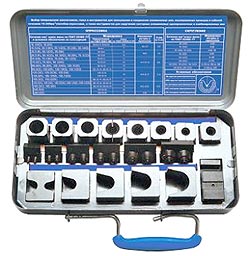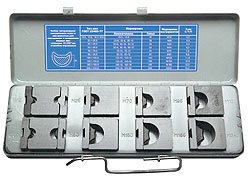Connection and termination of cable cores by crimping
Crimping is done with hand pliers, mechanical, pyrotechnic or hydraulic press using replaceable punches and dies. Punches and dies are selected according to the diameter of the pipe part of the tip or connecting sleeve. There are two pressing methods: local indentation and continuous pressing.
With a local countersink, ensure that the holes are located coaxially with the core to be pressed and with each other. On completion, wells are made on the face of the top. For quality control, the depth of the indentation (holes) with a fair indentation or the degree of continuous compression is selectively checked for at least 1% of the tops and sleeves.
When using a hydraulic press with automatic indentation or squeeze depth control, there is no need for selective control of pressing quality.
Consider the sequence of the crimping operation.
Crimping of aluminum single-core wires of cables cross-section 2.5 — 10 mm2.
Crimping is done in GAO sleeves.The sleeve is selected in accordance with the number and cross-section of the wires that will be connected.
Crimping is carried out in a certain technological sequence: they select a sleeve, tools and mechanisms, drill and punches, clean the ends of the veins (in lengths of 20, 25 and 30 mm for sleeves GAO-4, GAO-5, GAO -b and GAO-8 respectively) and the inner surface of the bushing to a metallic luster and immediately lubricate them with quartz-vaseline paste (cleaning and lubrication of the bushings is carried out if this is not done at the factory), insert cores into the sleeve.
If the total cross-section of the connecting wires is less than the diameter of the inner hole of the sleeve, additional wires must be inserted into the wires to seal the connection point. Crimping is done until the die comes into contact with the die.
After pressing, the remaining thickness of the material should be with sleeves GAO-4-Z, 5 mm, GAO-5 and GAO-b — 4.5 mm, GAO -8 — b, 5 mm. Before insulation, the finished contact connection is wiped with a cloth soaked in gasoline. Insulate the pressing area with insulating tape.
With one-sided entry of the core into the sleeve and sleeve diameters of 7 and 9 mm, polyethylene caps are used instead of insulating tape.
Crimping of single-wire and multi-wire cable cores cross-section 16 — 240 mm2
 Crimping of tips is carried out in aluminum and copper-aluminum ears according to and pins, crimping of connections — in aluminum bushings.
Crimping of tips is carried out in aluminum and copper-aluminum ears according to and pins, crimping of connections — in aluminum bushings.
The work is carried out in the following sequence: a tip or connecting sleeve is selected, a punch, a die and a pressing mechanism. Then check for a layer of quartz-vaseline paste on their inner surface.
If the tips or linings are received from the factory without lubricant, then clean the inner surface with a rag dipped in gasoline and smeared with paste. The insulation is then removed from the ends of the core when terminated — to a length equal to the length of the pipe section at the tip, and when connected — to a length equal to half the length of the sleeve.
The core, deprived of insulation, is cleaned with a brush of cardo tape to a metallic luster and immediately lubricated with quartz-vaseline paste. Before removing the cores with impregnated paper insulation, they should be wiped with a cloth soaked in gasoline.
If the veins are sectored, they are rounded before stripping. The operation of rounding multi-wire wires is carried out with pliers, and single-wire - with the help of a mechanical or hydraulic press, in which a special tool is installed instead of a punch and a die.
After the cores are prepared for crimping, a tip or sleeve is placed over them. When terminating, the core is inserted into the tip until it stops, and when a connection — so that the ends of the connecting wires are in contact with each other in the middle of the sleeve. The tubular part of the tip or sleeve is installed in the mold and crimped.
If at the same time the crimping is done with a punch with one tooth, then two recesses are made on the tip and on the sleeve — four (two for each end of the connected wires). If it is pressed with a punch with two teeth, then one dent is made on the tip and on the sleeve - two.
The indentation is made up to the stop of the perforator at the end of the die. This is exactly how the depth of the indentation is checked caliper with a nozzle or a special meter.
After pressing, the remaining thickness of the material should be: in the cross section of the cores 16 — 35 mm2 — 5.5 mm, with a section of 50 mm2 — 7.5 mm, with a section of 70 and 95 mm2 — 9.5 mm, with a section of 120 and 150 mm2 — 11, 5 mm, with a section of 185 mm2 — 12.5 mm, with a section of 240 mm2 — 14 mm.
When crimping with a press that has automatic crimp quality control (indentation depth), there is no need for this check. Before applying the insulation, the sharp edges of the sleeve are cut, rounded and cleaned with fine sandpaper.
When crimping the connections of the conductors of 6-10 kV cables, measures are taken to equalize the electric field, the symmetry of which is broken relative to the places of the recesses. Concentration zones electric field lines can be centers of occurrence of local discharges, which leads to the destruction of the insulation. To avoid these phenomena, a screen made of a single layer of semiconductor paper is applied directly to the sleeve.
It should be remembered that you should not use tips and sleeves that do not correspond to the section and type of core, as well as use inappropriate punches and dies. It is also impossible to "bite off" the wires to facilitate insertion of the core into the ferrule or bushing and to perform a pressure test without lubricating the cores and bushings with quartz-vaseline paste. Single-wire conductors 25 — 240 mm2, terminated by stamping a ferrule on the conductor.
To complete the termination, remove from the end of the wire insulation along the length: for wires with a cross section of 25 mm2 — 45 mm, for 35 — 96 mm2 — 50 mm, for 120 — 240 mm2 — 56 mm.
Select strike and die depending on core cross-section.Stamping is done using pyrotechnic mechanisms. The perforator under the action of powder gases pierces the tip, forming it from the end of the core.
In the case of an inaccurate design of the tip, it is allowed to re-pierce with a reduction in the force of the re-shot, for which the impact is not brought to the upper end position by 5 — 7 mm.
There should be no visible cracks, pits, overlaps and dents on the stamped part of the tip, there should be alignment of the bolt hole in the contact part of the tip. After five shots, the forming part of the punch should be lubricated with a thin layer of machine oil.
Crimping of stranded copper wires of cables 1 — 2.5 mm2.
Crimping is done with crimping pliers in ring copper lugs crimped with special punches and dies.
Before crimping the ring lugs, remove the insulation from the end of the core to a length of 25 — 30 mm, clean the core to a metallic luster, twist it tightly with pliers, select the tip, punch and die corresponding to the cross section of the core; place them in press pliers, place the core in the tip, place the tip with a vein placed in it on the punch so that the vein comes out through the groove of the punch, crimp the tip with press pliers until the punch washer stops at the end of the die.
Solid and stranded 4 — 240 mm2.
 The termination of the 4 — 240 mm2 core is made in copper lugs, and the connection of the core is 16 — 240 mm2 in the sleeves. The sequence of the crimping operation is the same as when crimping aluminum wires, but lubrication with quartz-vaseline paste is not required.
The termination of the 4 — 240 mm2 core is made in copper lugs, and the connection of the core is 16 — 240 mm2 in the sleeves. The sequence of the crimping operation is the same as when crimping aluminum wires, but lubrication with quartz-vaseline paste is not required.
Crimping copper lugs and sleeves is done with a punch and die with a single tooth, one recess is made on the tip, two on the sleeve, one for each end of the connected wires.
